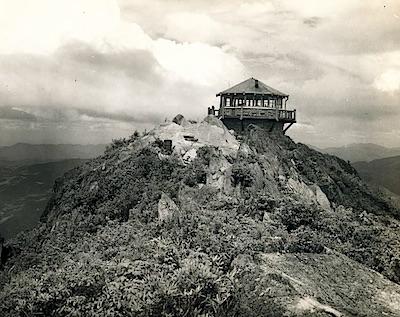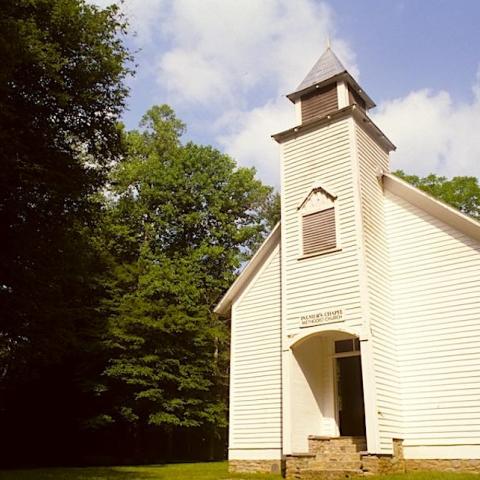A fall excursion to Great Smoky Mountains National Park doesn't have to be crowded. Head to the Cataloochee Valley and experience the setting as early settlers did. Stand in the Palmer Barn and you can get a sense of their life here/Luke Daniel
Visitors come to Great Smoky Mountains National Park for many reasons. They want to hike the more than 70 miles of the rugged Appalachian Trail that meander through the park, to camp in its dense forests, to cool off in one of its many streams, or to take a leisurely drive along the scenic Newfound Gap Road that crosses the heart of the park to connect Tennessee with North Carolina. Regardless of the reason, they come—in droves. Every year, 8-10 million people travel to the Smokies, making it the most-visited national park in the country.
Whether you’re planning a trip to the park this fall, or any other season, how do you avoid seeing it through the tailgate of a stranger’s station wagon? Simply bypass the most popular attractions around Cades Cove and Gatlinburg and head east to Cosby and Cataloochee. Spending time in these lesser-known areas affords you the unique opportunity to get a quintessential Smoky Mountains experience without the crowds.
Camp In This Quiet Corner
Cosby Campground is located just outside the tiny hamlet of Cosby, Tennessee. Much like the town, this is one of the quieter campgrounds in the park. It rarely fills up, even on holiday weekends. There are 131 sites available on a firstcome, first-served basis and 26 sites that can be reserved in advance.
The sites are beautiful and spacious, with tall trees perfectly situated for hanging a hammock, a terraced-off camp pad, a fire ring, and a picnic table. Restrooms with flush toilets and drinking water are a short walk away. And the camp hosts do an admirable job of clearing out the overgrown daddy long-legs that have taken-up residence near the sinks.
Once you select your site and get situated, stretch your legs on a moderate 4.4-mile round-trip hike to Hen Wallow Falls. The trailhead is located just off the parking lot adjacent to the picnic area. Follow the Gabes Mountain Trail through a forest thick with rhododendron and ferns growing densely under the shady canopy of hemlock and yellow poplar. Roughly two miles in, watch for a wooden sign marking a short side trail that leads to Hen Wallow Falls. The trail down to the falls is steep, requiring sturdy shoes along with your full attention. You will begin to hear the sound of Hen Wallow Creek cascading down over 90 feet of glistening rock and neon-green moss. Linger here as long as you like. Odds are, you will have the view to yourself.
Head For The High Country
Most visitors have a vision of how they’d like to see the park, and it typically involves climbing to the top of a mountain like 4,928-foot Mount Cammerer. This is a very strenuous hike involving a breathtaking amount of elevation gain along the rugged Low Gap and Appalachian trails. Weather in the Smokies is unpredictable; it can change rapidly, so you should carry a daypack containing rain gear, a warm layer, food, water and a trail map. Get an early start, particularly during the shorter days of fall, because this 15-mile round-trip hike takes approximately six to eight hours to complete. Plus, you’ll want to have plenty of time to explore the historic fire tower located atop Mount Cammerer.

It can be a challenging, uphill hike, but make the trek to the top of Mount Cammerer and enjoy the view from the historic fire lookout tower / State of Tennessee
To get there, make your way through the Cosby Campground toward Cosby Creek and pick up the Low Gap Trail. Follow the well-defined path through the dense hardwood forest running parallel to the creek. The Low Gap Trail climbs up and out of the Cosby Creek Valley for the first three miles. Each step forward is also a step up over uneven tree roots and rocks. Around the three-mile mark, you’ll come to a clearing in the woods and see a small wooden sign marking the Appalachian Trail. At this point, you will have already climbed more than 2,000 feet.
The hike gets easier once you’re on the A.T. The path begins to level off around mile four, and sporadic breaks in the foliage reveal incredible views of the Cosby and Toms Creek valleys below. Roughly five miles in, you will follow a short side trail to the summit of Mount Cammerer. The last half-mile forces you to scramble over large boulders and follow a series of disorientating switchbacks. But your efforts are rewarded the moment you set eyes on the wooden fire tower built high on a base of granite boulders.
Local laborers and the Civilian Conservation Corp built the fire tower in the 1930s. Each year between February 15th and May 15th, then again from October 15th through December 15th, the structure was manned by lookouts who lived on the premises for two weeks. This system was replaced in the 1960s by more modern fire detection methods.
Views from the wooden platform lining the perimeter of the tower are breathtaking. Before you is an endless expanse of undulating forest stretching to the horizon. Mountains rise gracefully from the forest floor. Clouds float swiftly below, momentarily obscuring the unparalleled beauty surrounding you. This is the view of Great Smoky Mountains National Park you came to see.
History And Wildlife Abound In Cataloochee
After a big day of hiking, give your legs a rest and drive to Cataloochee, North Carolina. Distance-wise, it’s only about 40 miles from Cosby, but Cove Creek Road is a narrow, twisting, gravel road that skates along the side of deep ravines and dips in and out of the backwoods. The scenery is outstanding, but this drive is not for those who are in a hurry or sensitive to motion sickness.
After bouncing over rocks and winding around curves for an hour, you’ll start to descend into the Cataloochee Valley. Nestled inside some of the tallest mountains in the southeastern United States, the valley was once a thriving community. In 1910, approximately 1,200 people lived, worked, worshiped and went to school here. Few people remained in the area after the establishment of the national park in 1934. All that remains today are a handful of homes and barns, two churches, and a school scattered across the Little and Big Cataloochee valleys. There are no tour guides present to usher you through the structures and no ropes restricting access to certain areas. Unlike the very popular Cades Cove area, there are virtually no crowds to compete with either, so you can explore the well-preserved buildings at your leisure.

Catch the fall colors along Cataloochee Creek in Great Smoky Mountains National Park without the crowds/NPS
In Big Cataloochee you’ll find homes with wallpapered bedrooms, kitchens with dining room tables, and barns stocked with hay and old equipment. The Beech Grove School has desks organized in neat rows facing the chalkboard. And the Palmer Chapel has an open Bible on its pulpit.
Perhaps the valley’s best-known attraction is its flourishing elk population. Once prevalent in the region, elk were eradicated by the 1700s due to over-hunting and loss of habitat. The National Park Service began returning elk to the Cataloochee Valley in 2001 and the population has been growing ever since. They can be a bit elusive to spot, but if you arrive early in the morning or remain into the evening you may be able to see a herd grazing alongside wild turkeys in the fields.
Come visit the eastern side of Great Smoky Mountains National Park this fall and experience the best the park has to offer instead of its traffic jams.






 Support Essential Coverage of Essential Places
Support Essential Coverage of Essential Places






